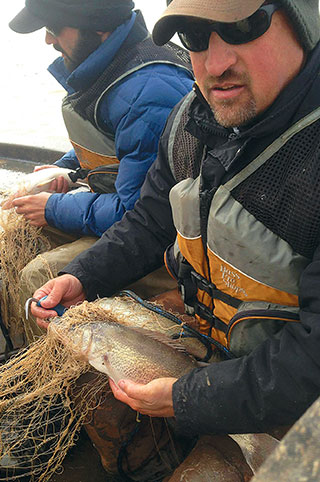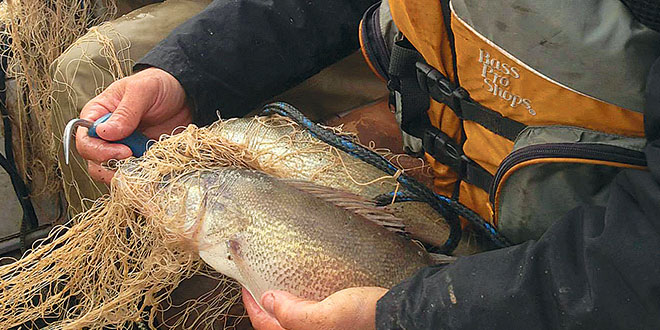Timing is right to target walleye
As the last rays of daylight fade over the horizon, a voracious predator with needle-like teeth and large reflective eyes goes on the prowl.
It’s not a large, furry mammal, but a fish.
Walleye are a popular sport fish because of their delicious white, flaky meat that lacks the typically strong, fishy taste. They can be found in most large lakes across the state, but their natural reproduction is limited in New Mexico.
“The majority of waters in New Mexico don’t have enough suitable spawning habitat for walleye, such as gravel- to cobble-sized substrate free of sediment that can choke eggs,” said Eric Mammoser, warmwater fisheries biologist for the New Mexico Department of Game and Fish.
As a result, department biologists conduct artificial spawning to support the species and provide angling opportunities.
In late March and early April, Game and Fish personnel can be found at Conchas Lake spawning walleye.
Sexually mature walleye, 4 years and older, are moved to lakeside net pens for holding. Fish are squeezed over a pan, releasing eggs from the females or milt from the males. The contents are then stirred together using a crane or turkey feather and the now fertilized eggs are brought to Rock Lake Hatchery near Santa Rosa for rearing. Fry, newborn fish about one-fourth inch long, are raised for four to seven days and then stocked around the state.
In recent years, factors such as low water levels have caused many of the state’s walleye populations to decrease. Conchas Lake, considered the primary brood lake, was hit especially hard, making it difficult for Game and Fish personnel to collect enough eggs to support walleye stocking.
“We try to maintain a stocking rate of 500 fry per surface acre of water,” Mammoser said. “In recent years, fry or eggs from the Genoa National Fish Hatchery in Wisconsin and other agencies helped us meet our stocking goals.
“This past year’s spawn was a great success. A large cohort of walleye that have been watched at Conchas Lake for several years reached sexual maturity. The large numbers of adult walleye led to one of the highest egg collections in almost a decade.”
With eggs received from the Genoa National Fish Hatchery and Iowa Department of Natural Resources and eggs/fry from Colorado Parks and Wildlife, Game and Fish met the stocking recommendations at all New Mexico lakes.
“Meeting the recommendations would not have been possible without those cooperating agencies, “Mammoser said. “Our hope is that 2016 will mark the beginning of a new trend: spawning enough walleye to fully support the stocking program and possibly return the favor of sending surplus eggs to other agencies in the future.”
The work doesn’t stop at stocking young fish.
“Any fish that died in gill nets during fall surveys are collected because crucial data needed to assess population health and growth can be studied,” Mammoser said. “A tiny bone in the fish “ear” – called the otolith – can be read like tree rings to estimate age.

“Based on average age estimates, researchers can continually evaluate the success of management practices, such as stocking rates.”
The success of the stocking program translates to improved opportunity for anglers wanting to taste the non-fishy fish.
And finding them isn’t difficult in New Mexico.
Walleye can be found in Ute, Conchas, Santa Rosa, Sumner, Abiquiu, Clayton and Stubblefield lakes. Smaller numbers occur in Cochiti Lake, Caballo Lake and Elephant Butte Reservoir. The state record walleye, caught at Clayton, tipped the scale at 16 pounds, 9 ounces.
“Clayton may have lower numbers, but larger individuals can be found,” Mammoser said. “Eight to 10 pounds is a big walleye.”
The best time for anglers to target walleye is around dusk and into the night during the spring when they are preparing to spawn. Their large eyes work great in low light and they cruise shallows in darker hours, chasing their primary food source: shad. This makes rocky shorelines or points the premium locations.
An effective, inexpensive bait is a 3-inch white, curly-tail grub lure, but anything that mimics shad, such as crank bait or live bait, where legal, will work.
Walleye “keepers” must be at least 14 inches long and anglers are allowed to keep five per day and have no more than 10 in possession.
“They’re definitely one of the better-tasting freshwater fish,” Mammoser said. “When considering how to prepare walleye, you can’t go wrong with beer-battered.”
 New Mexico Wildlife magazine Conserving New Mexico's Wildlife for Future Generations
New Mexico Wildlife magazine Conserving New Mexico's Wildlife for Future Generations
